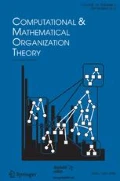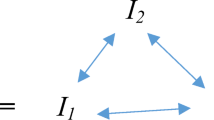Abstract
Social action is situated in fields that are simultaneously composed of interpersonal ties and relations among organizations, which are both usefully characterized as social networks. We introduce a novel approach to distinguishing different network macro-structures in terms of cohesive subsets and their overlaps. We develop a vocabulary that relates different forms of network cohesion to field properties as opposed to organizational constraints on ties and structures. We illustrate differences in probabilistic attachment processes in network evolution that link on the one hand to organizational constraints versus field properties and to cohesive network topologies on the other. This allows us to identify a set of important new micro-macro linkages between local behavior in networks and global network properties. The analytic strategy thus puts in place a methodology for Predictive Social Cohesion theory to be developed and tested in the context of informal and formal organizations and organizational fields. We also show how organizations and fields combine at different scales of cohesive depth and cohesive breadth. Operational measures and results are illustrated for three organizational examples, and analysis of these cases suggests that different structures of cohesive subsets and overlaps may be predictive in organizational contexts and similarly for the larger fields in which they are embedded. Useful predictions may also be based on feedback from level of cohesion in the larger field back to organizations, conditioned on the level of multiconnectivity to the field.
Similar content being viewed by others
References
Adamic, L.A., R.M. Lukose and B.A. Huberman (2003), “Local Search in Unstructured Networks,” in S. Bornholdt and H.G. Schuster (Eds.), Handbook of Graphs and Networks: From the Genome to the Internet. Berlin: Wiley-Europe, http://arxiv.org/abs/cond-mat/0204181.
Amaral, L.A.N., A. Scala, M. Berthélémy and H.E. Stanley (2000), “Classes of Small-World Networks,” Proc.Natl.Acad.Sci.USA, 97, 11149–52, http://polymer.bu.edu/ ~amaral/Papers/pnas00a.pdf.
Barabási, A.-L. (2002), Linked: The New Science of Networks. Cambridge, MA: Perseus Publishing.
Barabási, A.-L. (2003), “Emergence of Scaling in Complex Networks,” in S. Bornholdt and H.G. Schuster (Eds.), Handbook of Graphs and Networks: From the Genome to the Internet. Berlin: Wiley-VCH.
Batagelj, V. and A. Mrvar (2001), “A Subquadratic Triad Census Algorithm for Large Sparse Networks with Small Maximum Degree,” Social Networks, 23, 237–243.
Bollobás, B. and O.M. Riordan (2003), “Mathematical Results on Scale-Free Random Graphs,” in S. Bornholdt and H.G. Schuster (Eds.). Handbook of Graphs and Networks: From the Genome to the Internet. Berlin: Wiley-VCH, pp. 1–33.
Bourdieu, P. (1992), “The Logic of Fields,” in P. Bourdieu and L. Wacquant (Eds.). An Invitation to Reflexive Sociology. Chicago: University of Chicago Press, pp. 94–114.
Brudner, L.A. and D.R. White (1997), “Class, Property and Structural Endogamy: Visualiz-ing Networked Histories,” Theory and Society, 25, 161–208, http://eclectic.ss.uci.edu/ ~drwhite/ T&S/BrudnerWhite1997Convert.pdf.
Burt, Ronald S. (1992), Structural Holes: The Social Structure of Competition. Harvard University Press.
Coase, R. (1937), “The Nature of the Firm,” Economica, 4(16), 386–405, New Series, http://www.jstor.org/ view/00130427/di009864/00p00034/0.
Davis, A., B.B. Gardner and M.R. Gardner (1941), Deep South. Chicago: The University of Chicago Press.
Davis, J.A. and S. Leinhardt (1972), “The Structure of Positive Interpersonal Relations in Small Groups,” in J. Berger (Ed.), Sociological Theories in Progress. Boston: Houghton Mifflin, vol. 2, pp. 218–251.
Diestel, R. (2002, electronic edition), Graph Theory.New York, NY: Springer-Verlag, http://www.math.uni-hamburg. de/home/diestel/books/graph.theory/GraphTheoryII.pdf.
DiMaggio, P.J. and W.W. Powell (1983), “The Iron Cage Revisited: Institutional Isomorphism and Collective Rationality in Organizational Fields,” American Sociological Review, 48, 147–160.
Dorogovtsev, S.N. and J.F.F. Mendes (2003), Evolution of Networks: From Biological Nets to the Internet and WWW. Oxford: Oxford University Press.
Erdös, P. and A. Rényi (1961), “On the Evolution of Random Graphs,” Bulletin of the Institute of International Statistics, 38, 343–347.
Freeman, L.C. (2003), “Finding Groups: A Meta-Analysis of the Southern Women Data,” in R. Breiger, K. Carley and P. Pattison (Eds.). Dynamic Social Network Modeling and Analysis.Washington: The National Academies Press.
Freeman, L.C. and D.R. White (1993), “Using Galois Lattices to Represent Network Data,” Sociological Methodology, 23, 127–146. Website: http://www.jstor.org/view/00811750/ap010023/01a00050/.
Friedkin, N.E. (1998), A Structural Theory of Social Influence.New York: Cambridge University Press.
Giddens, A. (1986), The Constitution of Society. Berkeley: University of California Press.
Granovetter, M. (1985), “Economic Action and Social Structure: The Problem of Embeddedness,” American Journal of Sociology, 91(3), 481–510.
Granovetter, M. (1992), “Problems of Explanation in Economic Sociology,” in N. Nohria and R. Eccles (Eds.). Networks and Organizations. Boston, MA: Harvard Business School Press, pp. 25–56.
Harary, F. (1969), Graph Theory. Addison-Wesley Publishing Company.
Johnsen, E.C. (1985), “Network Macrostructure Models for the Davis-Leinhardt Set of Empirical Sociomatrices,” Social Networks,7,203–224.
Kleinberg, J. (2000), “Navigation in a Small World,” Nature, 506, 845, http://www.cs.cornell.edu/ home/kleinber/nat00.pdf.
Leaf, M. (2004), “Cultural Systems and Organizational Processes,” Cybernetics and Systems, 10, 289–313.
Likert, R. (1961), New Patterns of Management.New York: McGraw Hill.
March, J.G. and H.A. Simon (1958), Organizations.New York: John Wiley.
Maslov, S., K. Sneppen and U. Alon (2002), “Correlation Profiles and Circuit Motifs in Complex Networks,” in Handbook of Graphs and Networks. John Wiley and VCH Publishers. Berlin: Wiley-Europe.
Menger, K. (1927), “Zur allgemeinen Kurventheorie,” Fundamenta Mathematicae 10, 96–115.
Moody, J. (2003), “Epidemic Potential in Human Sexual Networks: Connectivity and the Development of STD Cores.” Presented at the Institute for Mathematics and its Applications, University of Minnesota, November 15–21, 2003. http://www.sociology.ohio-state.edu/jwm/presentations/ima talk.ppt
Moody, J. (2004 forthcoming), “The structure of a Social Science Collaboration Network: Disciplinary Cohesion from 1963–1999,” American Sociological Review.
Moody, J. and D.R. White (2003), “Social Cohesion and Embeddedness: A Hierarchical Conception of Social Groups,” American Sociological Review, 8(1), 1–25. URL preprint: http://www.santafe.edu/ sfi/publications/Abstracts/00-08-049abs.html. NetMiner (accessed 2004), http://www.netminer.com/NetMiner/pdf/ReferencePart1.pdf.
Newman, M.E.J. and J. Park (2003), “Why Social Networks are Different from Other Types of Networks,” Phys.Rev. E,in press. http://arxiv.org/abs/cond-mat/0305612.
Newman, M.E.J., S.H. Strogatz and D.J. Watts (2001), “Random Graphs with Arbitrary Degree Distributions and their Applications,” Phys.Rev. E, 64, 026118.
Owen-Smith, J., W.W. Powell and K.W. Koput (2004, forthcoming), “Pathways to an Open Elite,” in J. Padgett and W.W. Powell (Eds.). Network Emergence and Transformation. auj]Robins, G.L., J. Woolcock and P. Pattison (in press). Small and Other Worlds: Global Network Structures from Local Processes. American Journal of Sociology.
Powell, W.W. (1990), “Neither Market nor Hierarchy: Network Forms of Organization,” Research in Organizational Behavior, 12, 295–336.
Powell, W.W. (1996), “Inter-Organizational Collaboration in the Biotechnology Industry,” Journal of Institutional and Theoretical Economics, 120(1), 197–215.
Powell, W.W., and P.J. DiMaggio (1991), The New Institutionalism in Organizational Analysis. Chicago: The University of Chicago Press.
Powell, W.W., D.R. White, K.W. Koput and Jason Owen-Smith (2004, forthcoming), “Network Dynamics and Field Evolution: The Growth of Interorganizational Collaboration in the Life Sciences,” American Journal of Sociology in press.
Rapoport, A. (1957), “Contribution to the Theory of Random and Biased Nets,” Bulletin of Mathematical Biology, 19, 257–277.
Sewell, W.F. (1992), “A Theory of Structure: Duality, Agency, and Transformation,” American Journal of Sociology, 98, 1–29.
Simon, H. (1947), Administrative Behavior.New York, NY: Macmillan.
Snijders, T.A.B. (2001), “The Statistical Evaluation of Social Network Dynamics,” in M.E. Sobel and M.P. Becker (Eds.). Sociological Methodology 2001, Boston and London: Basil Blackwell, pp. 361–395.
Stinchcombe, A. (1990), Information and Organizations. Berkeley: University of California Press.
Uzzi, B. (1996), “The Sources and Consequences of Embeddedness for the Economic Performance of Organizations: The Network Effect,” American Sociological Review, 61, 674–698.
Weber, M. (1968), Economy and Society.G. Roth and C. Wittich (Eds.). New York: The Citadel Press.
White, H.C. (2002), Markets into Networks. Princeton, NJ: Princeton University Press.
White, D.R. and F. Harary (2001), “The Cohesiveness of Blocks in Social Networks: Node Connectivity and Conditional Density,” Sociological Methodology, 31(1), 305–359. Blackwell Publishers, Inc., Boston, USA and Oxford, UK. http://www.blackwellpublishing.com/abstract.asp?ref=0081-1750&vid=31&iid=1&aid=98&s=&site=1
White, D.R. and M. Houseman (2002), “The Navigability of Strong Ties: Small Worlds, Tie Strength and Network Topology,” Complexity, 8(1), 72–81, http://eclectic.ss.uci.edu/~drwhite/Complexity.
White, D.R. and U.C. Johansen (2004), Network Analysis and Ethnographic Problems: Process Models of a Turkish Nomad Clan. Boston: Lexington Press.
Author information
Authors and Affiliations
Rights and permissions
About this article
Cite this article
White, D.R., Owen-Smith, J., Moody, J. et al. Networks, Fields and Organizations: Micro-Dynamics, Scale and Cohesive Embeddings. Computational & Mathematical Organization Theory 10, 95–117 (2004). https://doi.org/10.1023/B:CMOT.0000032581.34436.7b
Issue Date:
DOI: https://doi.org/10.1023/B:CMOT.0000032581.34436.7b




